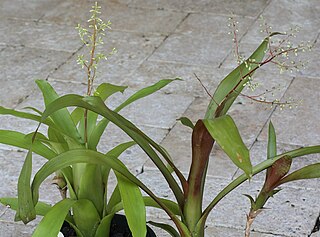
The Bromeliaceae is a family of monocot flowering plants of 75 genera and around 3590 known species native mainly to the tropical Americas, with several species found in the American subtropics and one in tropical west Africa, Pitcairnia feliciana.

Bromelia is a genus of about 70 plant species widespread across Latin America and the West Indies. It is the type genus of the family Bromeliaceae, subfamily Bromelioideae, and its type species is B. karatas. Bromelia species are are characterized by flowers with a deeply cleft calyx. The genus is named after the Swedish medical doctor and botanist Olof Bromelius (1639-1705).

Vriesea is a genus of flowering plants in the botanical family Bromeliaceae, subfamily Tillandsioideae. The genus name is for Willem Hendrik de Vriese, Dutch botanist, physician (1806–1862). Its species are widespread over Mexico, Central America, South America and the West Indies.

Aechmea is a genus of flowering plants in the family Bromeliaceae. The name comes from the Greek aichme, meaning "spear". Aechmea comprises eight subgenera and around 250 species distributed from Mexico through South America and the Caribbean. Most of the species in this genus are epiphytes.

Canistrum is a genus of plants in the family Bromeliaceae, subfamily Bromelioideae.

Cryptanthus is a genus of flowering plants in the family Bromeliaceae, subfamily Bromelioideae. The genus name is from the Greek cryptos (hidden) and anthos (flower). The genus formerly had two recognized subgenera: the type subgenus and subgenus HoplocryptanthusMez which has been raised to the separate genus Hoplocryptanthus. All species of this genus are endemic to Brazil. The common name for any Cryptanthus is "Earth star".
Wittmackia is a genus in the family Bromeliaceae.

Pitcairnia is a genus of plants in the family Bromeliaceae, subfamily Pitcairnioideae. It was named for William Pitcairn, Scottish physician and gardener (1711–1791). The genus Pitcairnia ranks as the second most prolific of the bromeliad family. They are most abundant in Colombia, Peru and Brazil, but can also be found in areas from Cuba and Mexico south to Argentina. One species, Pitcairnia feliciana, is found in tropical West Africa and is the only member of the family Bromeliaceae not native to the Americas.

Orthophytum is a genus in the plant family Bromeliaceae, subfamily Bromelioideae.

Hohenbergia is a genus of plants in the family Bromeliaceae, subfamily Bromelioideae. It is native to the West Indies, the Yucatán Peninsula, and northern South America.

Ronnbergia is a genus in the plant family Bromeliaceae, subfamily Bromelioideae. Native to South and Central America, this genus was named for Auguste Ronnberg, Belgian Director of Agriculture and Horticulture in 1874.

Tillandsia subg. Anoplophytum is a subgenus of the genus Tillandsia.
Pseudaraeococcus chlorocarpus is a species of flowering plant in the family Bromeliaceae, native to Brazil. It was first described in 1862 as Lamprococcus chlorocarpus.
Pseudaraeococcus montanus is a species of flowering plant in the family Bromeliaceae, endemic to Brazil. It was first described in 1999 as Araeococcus montanus.
Pseudaraeococcus nigropurpureus is a species of flowering plant in the family Bromeliaceae, endemic to Brazil. It was first described in 2007 as Araeococcus nigropurpureus.

Pseudaraeococcus parviflorus is a species of flowering plant in the family Bromeliaceae, endemic to Brazil. It was first described in 1830 as Billbergia parviflora.
Pseudaraeococcus sessiliflorus is a species of flowering plant in the family Bromeliaceae, endemic to Brazil. It was first described in 2007 as Araeococcus sessiliflorus.

Wallisia is a genus of flowering plants belonging to the family Bromeliaceae. It is also in the Tillandsioideae subfamily.

Lemeltonia is a genus of flowering plants belonging to the family Bromeliaceae.
Pseudaraeococcus is a genus of flowering plant in the family Bromeliaceae, native to northeastern Brazil. It was first described as the subgenus Pseudaraeococcus of the genus Araeococcus by Carl Christian Mez in 1935, and raised to a separate genus in 2020.














